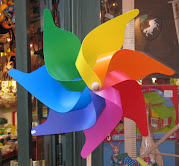 I have to admit I have not been faithful to my blog but am busy blogging elsewhere on a blog noone else can read - yes even more free-fall than my jottings here! It's my way of trying to get over writer's block and start the paper I need to get done for my course with the Craighead Institute.
I have to admit I have not been faithful to my blog but am busy blogging elsewhere on a blog noone else can read - yes even more free-fall than my jottings here! It's my way of trying to get over writer's block and start the paper I need to get done for my course with the Craighead Institute.
One of the ideas I'm interested in for the paper is "the three-ringed circus". Just by googling I've discovered that the term is used used in all sorts of ways in management and business, mainly to mean the best of all possible solutions: to your IT problems, to inspiring your fundraising team or improving your (macho) mastery of the strategic environment. Sometimes though the term seems to be used as an image of chaos, a space that is potentially creative but not easy to control.
While we were learning about healthy and sick organisations one of the things we were encouraged to understand is that no organisation is ever completely healthy or completely sick. Even when things are going really, really well the image is the three-ringed circus and not a perfectly ticking Swiss clock! If your organisation is generally healthy it will not be possible to control and keep tabs on everything all the time.
Anyway one of the interesting things about the circus that I have discovered in recent months is that it is also something that interests some theologians. On Ben Myers Faith and Theology blog he has this great quote from William Stringfellow on the theological significance of the circus: “In the circus, humans are represented as freed from consignment to death. There one person walks on a wire fifty feet above the ground … another hangs in the air by the heels, one upholds twelve in a human pyramid, another is shot from a cannon. The circus performer is the image of the eschatological person – emancipated from frailty and inhibition, exhilarant, transcendent over death – neither confined nor conformed by the fear of death any more…. So the circus, in its open ridicule of death … shows the rest of us that the only enemy in life is death and that this enemy confronts everyone, whatever the circumstances, all the time…. The service the circus does – more so, I regret to say, than the churches do – is to portray openly, dramatically, and humanly that death in the midst of life. The circus is eschatological parable and social parody: it signals a transcendence of the power of death, which exposes this world as it truly is while it pioneers the Kingdom” (A Simplicity of Faith, pp. 89-91).
Meanwhile there's a video interview here with Shane Claiborne who founded the Simple Way community in it he says: "you can get together and talk theology but if you can't juggle together what good is it."
Anyway while I think about all of that here's more from the Radio 4 blurb:
Midge Ure travels to Cape Town in South Africa to visit Zip Zap School of Circus Arts for Social Change. Midge is expecting the big top, bright lights and clowns in comedy big shoes and red noses, but this is something entirely different.
Founded in 1992 by Laurence and Brent van Rensburg, the vision for the Zip Zap circus school was to teach circus skills to South African children from all walks of life - from Cape Town's wealthy middle class elite to children born in the townships. Boys, girls, wealthy, homeless, extroverted, introverted, aged eight to 18, all have their places and responsibilities at Zip Zap, which attempts to embody Mandela's vision of the Rainbow Nation.
Midge meets Zip Zap's founders in Cape Town, and joins Shannon and Neville, two trainers from Zip Zap who travel to Khayelitsha township once a week to run the circus outreach programme there for kids born with HIV.
Shannon and Neville seem to embody what Zip Zap is all about. The former is a white American from Minneapolis who went over to train with Zip Zap and the latter is a black South African from Khayelitsha township - they got together at Zip Zap.
At the Khayelitsha outreach programme, there is no big top or paying audiences, just 25 children aged between eight and 13 who were all born with HIV. They practise circus skills in the street, including juggling, unicycle and throwing hoops. Midge is initially a little sceptical about how teaching circus skills to kids born with HIV can improve their lives. He hears how they have been ostracised by their own communities and how the circus workshops attempt to enable these children to develop their physical strength and abilities, while gaining self-confidence.
Midge says, 'I get it now. It's not about building up wonderful performers, it's about integration, it's about self-esteem. The circus works - it gives all these kids a focus, it gives them something to do, something to learn. But most importantly it gives them a little bit of hope.'






0 Comments:
Post a Comment